CONCH SHELLS FROM THE WORLD'S TROPICS
Conch is a common name of a number of different medium-to-large-sized sea snails. Conch shells typically have a high spire and a noticeable siphonal canal. The shell comes to a noticeable point on both ends.
(REF: Walters, Martin; Johnson, Jinny (2003). Encyclopedia of Animals. Marks and Spencer. )
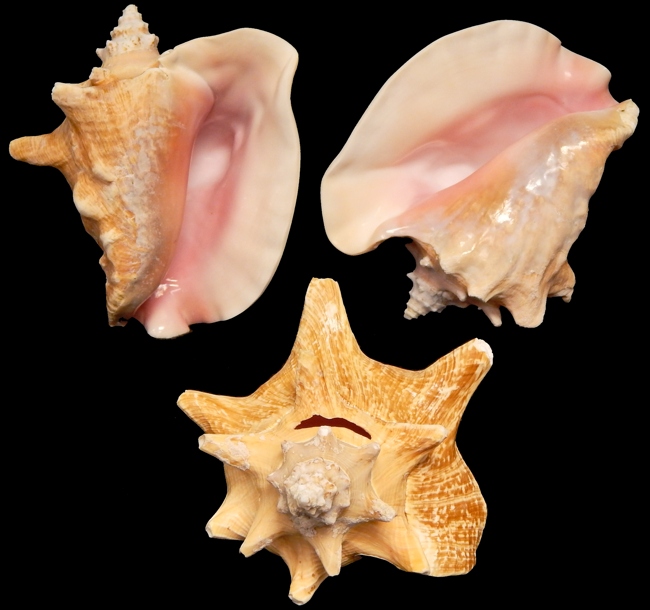
Aliger gigas, originally known as Strombus gigas, Common names include queen conch and pink conch.
ZZ1-28
One Pink Conch shell with Slit Back measuring 6 to 8 inches...... $7.00
ZZ2-28
One Pink Conch Slit Back measuring 8 inches or more........ $9.95
The mature conch shell grows to 6 to 12 inches in length in three to five years while the maximum reported size is about 14 inches. While growing the thickness of the shell is constantly increasing. The shell is very solid and heavy, with 9 to 11 whorls and a widely flaring and thickened outer lip. The thickness of the shell provides protection. When the shell size reaches its maximum, the outside shell gradually thickens.
The spire is a protruding part of the shell that includes all of the whorls except the largest and final whorl (known as the body whorl). It is usually more elongated than in other strombid snails, such as the closely related and larger goliath conch, Lobatus goliath that is endemic to Brazil. In A. gigas, the glossy finish or glaze around the aperture of the adult shell is primarily in pale shades of pink. It may show a cream, peach or yellow coloration, but it can also sometimes be tinged with a deep magenta, shading almost to red. The periostracum, a layer of protein (conchiolin) that is the outermost part of the shell surface, is thin and a pale brown or tan color.
A. gigas is not solely determined by the animal's genes; environmental conditions such as location, diet, temperature and depth, and biological interactions such as predation, can greatly affect it. Juvenile conches develop heavier shells when exposed to predators. Conches also develop wider and thicker shells with fewer but longer spines in deeper water.
The shells of juvenile queen conches are different in appearance from those of the adults. There is a complete absence of a flared outer lip; juvenile shells have a simple sharp lip, which gives the shell a conical or biconic outline. In Florida, juvenile queen conches are known as rollers, because wave action very easily rolls their shells, whereas it is nearly impossible to roll an adult specimen, due to the shell's weight and asymmetric profile. Subadult shells have a thin flared lip that continues to increase in thickness until death.
Conch shells are about 95% calcium carbonate and 5% organic matter.
Aliger gigas is gonochoristic, which means each individual snail is either distinctly male or distinctly female. Females are usually larger than males in natural populations, with both sexes existing in similar proportion. After internal fertilization, the females lay eggs in gelatinous strings, which can be as long as 75 feet. These are layered on patches of bare sand or seagrass. The sticky surface of these long egg strings allows them to coil and agglutinate (firmly stick or be stuck together to form a mass), mixing with the surrounding sand to form compact egg masses, the shape of which is defined by the anterior portion of the outer lip of the female's shell while they are layered. Each one of the egg masses may have been fertilized by multiple males. The number of eggs per egg mass varies greatly depending on environmental conditions such as food availability and temperature. Females generally produce 8–9 egg masses per season, each containing 180,000–460,000 eggs, but numbers can be as high as 750,000 eggs. A. gigas females may spawn multiple times during the reproductive season, which lasts from March to October, with activity peaks occurring from July to September.
Queen conch embryos hatch 3–5 days after spawning. At the moment of hatching, the protoconch (embryonic shell) is translucent and has a creamy, off-white background color with small, pustulate markings. This coloration is different from other Caribbean Lobatus, such as Lobatus raninus and Lobatus costatus, which have unpigmented embryonic shells. Afterwards, the emerging two-lobed veliger (a larval form common to various marine and fresh-water gastropod and bivalve mollusks) spend several days developing in the plankton, feeding primarily on phytoplankton. Metamorphosis occurs some 16–40 days from the hatching, when the fully grown protoconch is about 1/2 inch high. After the metamorphosis, A. gigas individuals spend the rest of their lives in the benthic zone (on or in the sediment surface), usually remaining buried during their first year of life. The queen conch reaches sexual maturity at approximately 3 to 4 years of age, reaching a shell length of nearly 8 inches and weighing up to 5 pounds. Individuals may live up to 7 years, though in deeper waters their lifespan may reach 20–30 years[ and maximum lifetime estimates reach 40 years. It is believed that the mortality rate tends to be lower in matured conchs due to their thickened shell, but it could be substantially higher for juveniles. Estimates have demonstrated that its mortality rate decreases as its size increases and can also vary due to habitat, season and other factors.
Aliger gigas (pink conch)is native to the tropical Western Atlantic coasts of North and Central America in the greater Caribbean tropical zone.
Aliger gigas lives at depths from 1 to 135 feet. Its depth range is limited by the distribution of seagrass and algae cover. In heavily exploited areas, the queen conch is more abundant in the deepest range. The queen conch lives in seagrass meadows and on sandy substrates.
Aliger gigas is a specialized herbivore, that feeds on macroalgae (including red algae, such as species of Gracilaria and Hypnea) seagrass and unicellular algae, they also feeding on algal detritus. The green macroalgae Batophora oerstedii is one of its preferred foods.
Pink (queen) conch populations have been rapidly declining throughout the years and have been mostly depleted in some areas in the Caribbean due to the fact that they are highly sought after for their meat and their value.
Presently, ocean acidification is a serious threat to the queen conch. Acidity levels are rising and adversely affecting shellfish larvae. Rising atmospheric CO2 levels result in rising levels of carbonic acid in seawater, which is particularly harmful to organisms with calcium carbonate shells and structures. Certain larval stages of shellfish are very sensitive to lower seawater pH.
In 2022, the US NOAA conducted a review of populations throughout its range; the study places it at a moderate risk of extinction over the next 30 years. The study also requested, and received comments from management agencies, nations and associations throughout the Caribbean regarding the status of the species, and implications of listing the species as Threatened under the US Endangered Species Act.
Sharp edges on the conch shells have been blunted before shipping, for safety reasons
Scientific classification
Scientific classificationEdit this classificationDomain: Eukaryota
Kingdom: Animalia
Phylum: Mollusca
Class: Gastropoda
Subclass: Caenogastropoda
Order: Littorinimorpha
Family: Strombidae
Genus: Aliger
Species: A. gigas
Binomial name: Aliger gigas(Linnaeus, 1758)
(REF: Linnaeus, C. (1758). Systema Naturae, 10th ed., vol. 1. 824 pp. Laurentii Salvii: Holmiae (Stockholm, Sweden).) (REF: Smith, M. (1940). World Wide Seashells: illustrations, geographical range and other data covering more than sixteen hundred species and sub-species of molluscs (1 ed.). Lantana, Florida: Tropical Photographic Laboratory.)(REF: Acosta, Charles C. (2006). "Impending Trade Suspensions of Caribbean Queen Conch under CITES: A Case Study on Fishery Impacts and Potential for Stock Recovery" (PDF). Fisheries. 32 (12)(REF: Maxwell, S.J.; Dekkers, A.M.; Rymer, T.L.; Congdon, B.C. (2020). "Towards resolving the American and West African Strombidae (Mollusca: Gastropoda: Neostromboidae) using integrated taxonomy". The Festivus. 52)(REF: Welch, J. J. (2010). "The "Island Rule" and Deep-Sea Gastropods: Re-Examining the Evidence")(REF: Tewfik, A. (1991)."An assessment of the biological characteristics, abundance, and potential yield of the queen conch (Strombus gigas L.) fishery on the Pedro Bank off Jamaica". Thesis submitted in partial fulfilment of the requirements for the Degree of Masters of Science (Biology). Acadia University, Canada.)(REF: Fish and Wildlife Research Institute (2006). "Queen conch: Florida's spectacular sea snail". Sea Stats. Florida Fish and Wildlife Conservation Commission. Archived from the original on 14 July 2011.)(REF:Robertson, R. (1959). "Observations on the spawn and veligers of conchs (Strombus) in the Bahamas". Proceedings of the Malacological Society of London. 33 (4) )(REF: "International Queen Conch Initiative". NOAA: Caribbean Fishery Management Council. Retrieved 27 September 2009.)(REF: Robertson, R. (1961). "The feeding of Strombus and related herbivorous marine gastropods". Notulae Naturae of the Academy of Natural Sciences of Philadelphia (343)(REF: Stoner, Allan W.; Davis, Martha H.; Kough, Andrew S. (2019). "Relationships between Fishing Pressure and Stock Structure in Queen Conch (Lobatus gigas) Populations: Synthesis of Long-Term Surveys and Evidence for Overfishing in The Bahamas". Reviews in Fisheries Science & Aquaculture. 27)(REF: "Standing Committee Recommendations". CITES Official Documents No 2003/057. 2003. Archived from the original on 21 October 2010. Retrieved 16 April 2010.)
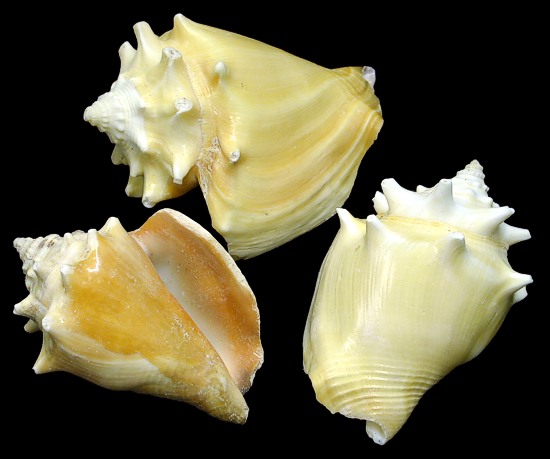
Strombus pugilis common names the fighting conch and the West Indian fighting conch
CC1-9
A Strombus pugilis (the Fighting Conch) shell measuring 2.5 to 3 inches...... .33
This is a species of medium to large sea snail, a marine gastropod mollusk in the family Strombidae, the true conchs.
The strombus pugilis grow up to 5 inches with the average size 3 1/2 inches.
Strombus pugilis has a robust, heavy solid shell, with a characteristic stromboid notch. It has a well-developed body whorl and a short and pointed spire. It grows 8 to 9 whorls, each of them having a single row of subsutural spines, becoming larger towards the last whorl. These spines may be less conspicuous or even absent in some populations. Its aperture is relatively long and slightly oblique. The posterior angle of the outer lip is distinct, projecting in the posterior direction in an erect fashion. The operculum is sickle-shaped, similar to several other Strombus snails.
The shell color varies from salmon-pink, cream or yellow to light or strong orange, and the interior of the aperture is usually white. The anterior end presents a dark purple stain, which is one of the diagnostic characters of this species, and is absent in Strombus alatus.
This species is closely similar to Strombus alatus, which has a more northerly range. Strombus alatus shells have less prominent subsutural spines and a slightly more projected outer lip. Some scientists have treated the two as distinct species; others as subspecies. In an extensive study of the Stromboidea in 2005, Simone provisionally treated them as distinct species, but observed that "no spectacular morphological difference was found [and] all related differences, even those of the genital system, can be regarded as extreme of variation of a single, wide distributed, variable species.
Strombus pugilis dwell from Bermuda, off southeastern Florida, the Caribbean Sea, and south to Brazil.
The Strombus pugilis can be found on sandy and muddy bottoms, from the intertidal zone to depths of a little over 180 feet.
During a long period in the initial stages of its development, the Strombus pugilis larvae feed mainly on plankton. Studies indicate that some populations of Strombus pugilis reproduce throughout the year. Reproduction orgies have been observed, on silty sand from depths between 26 to near 33 feet.
Strombus pugilis are herbivores, feeding on plants and algae.
The flesh of Strombus pugilis is edible. It is usually cooked by boiling, and is consumed by local fishermen. The shell is commonly used as a decorative item and is sold in local markets as a souvenir.
Scientific classification
Domain: Eukaryota
Kingdom: Animalia
Phylum: Mollusca
Class: Gastropoda
Subclass: Caenogastropoda
Order: Littorinimorpha
Family: Strombidae
Genus: Strombus
Species: S. pugilis
Binomial name: Strombus pugilis
Linnaeus, 1758
(REF: Welch J. J. (2010). "The "Island Rule" and Deep-Sea Gastropods: Re-Examining the Evidence".)(REF: Leal, J.H. (2002). Gastropods. p. 99-147. In: Carpenter, K.E. (ed.). The living marine resources of the Western Central Atlantic. Volume 1: Introduction, molluscs, crustaceans, hagfishes, sharks, batoid fishes, and chimaeras.)(REF: Simone (2005): Comparative Morphological study of representatives of the three families of Stromboidea and the Xenophoroidea (Mollusca, Caenogastropoda), with an assessment of their phylogeny)(REF:Robertson, R. (1961). The feeding of Strombus and related herbivorous marine gastropods. )
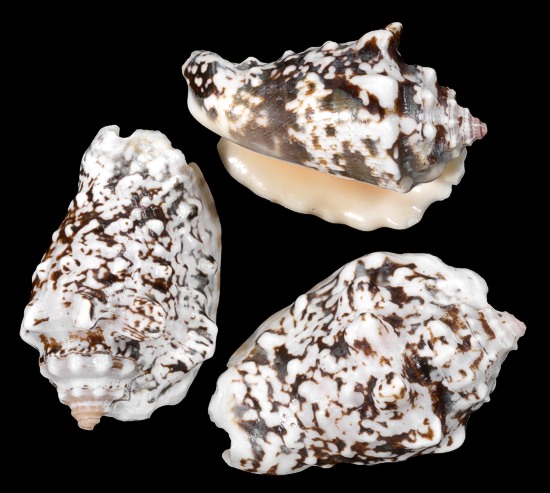
Lentigo lentiginosus, common name the silver conch
B1-9
A Strombus Lentiginosus (the Silver lip Conch) measuring 2 to 3.25 inches...... .333
The silver conch, is a species of medium-sized sea snail, a marine gastropod mollusk in the family Strombidae, the true conchs.
This species has been known to grow up to 4 inches.
The adult shell of Lentigo lentiginosus is very heavy and thick, with a characteristic deep stromboid notch, and a flared, very thick and posteriorly expanded outer lip. The columella is anteriorly projected, and the siphonal canal is convex. The body whorl has a notably irregular surface, which is ornamented by spiral cords and rows of blunt tubercles that form elevated knobs on the shoulder. The inner lip is smooth, with a large callus that often spreads over the spire and over the body whorl. The shell has a tall spire, and each whorl of the spire has a row of heavy knobs and groves that nearly completely fold over each other. The shell color is usually white with large irregular brown blotches and dots occurring at intervals over the shell surface. The columellar callus has a characteristic faint silvery gloss. The lateral margin of the outer lips has a series of tan blotches. The aperture is pink to orange on the interior, becoming paler towards the margins.
Lentigo lentiginosus is widespread across the Indo-Pacific, from East Africa, including Aldabra, Madagascar, Mauritius and Tanzania to eastern Polynesia, and also in southern Japan and northern Australia.
The silver conch dwells around coral and sandy bottoms in clear water. They are commonly found on barrier or lagoon reefs, in intertidal and shallow subtidal zones to a depth of around 13 feet. Lentigo Lentiginosus are rarely found living buried in the sand.
Lintogo lentiginosus are herbivores.
The flesh of Lentigo lentiginosus is edible, and it is locally collected for food. The shell is used in shell craft, and are commonly sold in local markets around the central Philippines.
\Scientific classification
Kingdom: Animalia
Phylum: Mollusca
Class: Gastropoda
(unranked): clade Caenogastropoda
clade Hypsogastropoda
clade Littorinimorpha
Superfamily: Stromboidea
Family: Strombidae
Genus: Lentigo
Species: Lentigo lentiginosus
Binomial name: Lentigo lentiginosus
(Linnaeus, 1758)
(REF: Strombus lentiginosus Linnaeus, 1758. Retrieved through: World Register of Marine Species)(REF: Poutiers, J. M. (1998). Gastropods in: FAO Species Identification Guide for Fishery Purposes: The living marine resources of the Western Central Pacific Volume 1. Seaweeds, corals, bivalves and gastropods)(REF: Johnson, S. (1977). Notes on the Shells Of Kwajalein Atoll. Hawaiian Shell News. Vol 25, no 11. Hawaiian Malacological Society)
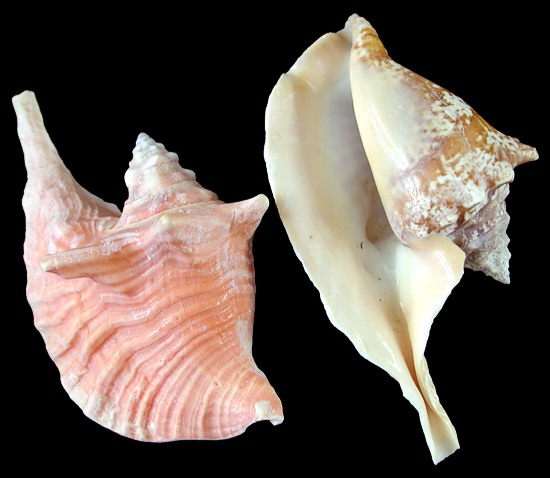
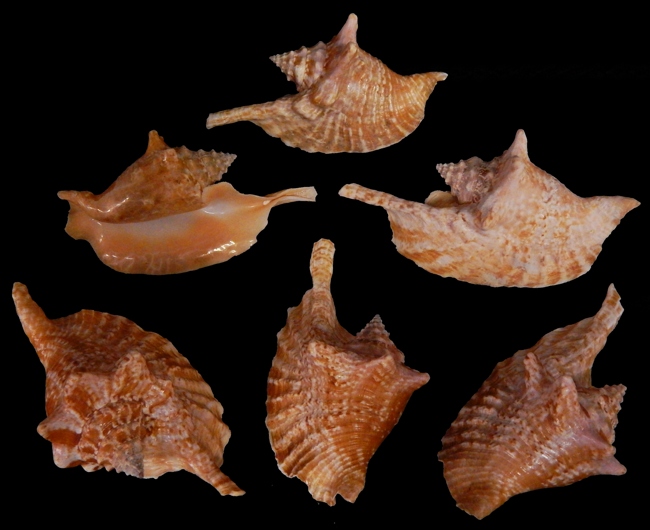
Aliger gallus common name Rooster Conch
C2-9
One Aliger gallus (Rooster Conch) measuring approximately 4 inches ...... $1.75
Aliger gallus, previously known as Strombus gallus, common name the rooster conch, is a species of medium-sized sea snail, a marine gastropod mollusk in the family Strombidae, the true conchs.
The Aliger Gallus dwells from southeast Florida and Bermuda through the West Indies, south to Brazil.
Rooster conch growth can reach up to 8 inches but these are rare, most do not grow over 5 inches.
These conchs live in depths from 1 to depths 269 feet.
Scientific classification
Domain: Eukaryota
Kingdom: Animalia
Phylum: Mollusca
Class: Gastropoda
Subclass: Caenogastropoda
Order: Littorinimorpha
Family: Strombidae
Genus: Aliger
Species: Aliger gallus
Binomial name: Aliger gallus
(Linnaeus, 1758)
(REF: Dance P. S. (1977). The Encyclopedia of Shells. Blandford Press, Dorset)(REF: MolluscaBase eds. (2020). MolluscaBase. Aliger gallus (Linnaeus, 1758). Accessed through: World Register of Marine Species)(REF: Welch J. J. (2010). "The "Island Rule" and Deep-Sea Gastropods: Re-Examining the Evidence")(REF:Lobatus Swainson, 1837. Retrieved through: World Register of Marine Species )
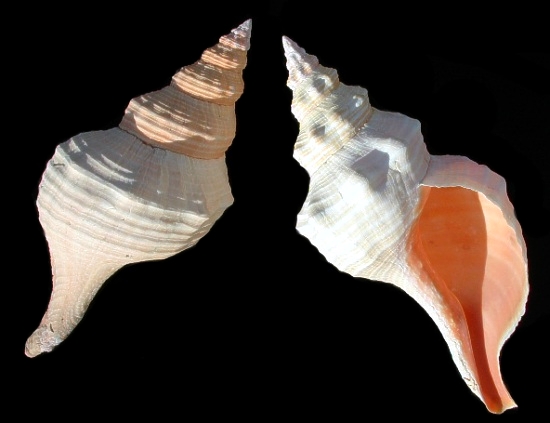
Triplofusus giganteus, commonly name Florida horse conch
T1-5
One Triplofusus giganteus (the Horse Conch) Shell measuring 8 to 10 inches ...... $16.95
T2-5
One Triplofusus giganteus (the Horse Conch) shell measuring 10 to 12 inches ...... $21.75
T3-5
One Triplofusus giganteus (the Horse Conch) shell measuring 12 to 13 inches ...... $30
T4-5
One Triplofusus giganteus (the Horse Conch) shell measuring 13 to 14 inches ...... $42
This species belongs to the of the large predatory subtropical and tropical sea snail, a marine gastropod mollusk in the family Fasciolariidae, the spindle snails, tulip snails and their allies.
The horse conch is not a true conch, it is not in the family Strombidae.
Triplofusus giganteus shell are known to grow up to 23 inches, this species is the largest gastropod in United States waters, and one of the largest gastropods in the world.
The largest known specimen of Triplofusus giganteus had a shell about 24 inches long. Populations have declined in size in recent years due to overharvesting; the largest individual shells observed in various recent surveys ranged from 13 to about 16 inches.
The outline of the shell is somewhat fusiform, with a long siphonal canal, and having up to 10 whorls. Its sculpture presents several spiral cords and axial ribs, some of which can form knobs on the whorls' shoulders.
Horse conchs dwell on sand, weed, and mud flats from the low intertidal to shallow subtidal zones, in depths of 0 to feet. They are found at depths ranging from 0 to 328 feet.
The shell color is bright orange in very young individuals. The shell often becomes greyish white to salmon-orange when adult, with a light tan or dark brown periostracum.The horse conch sea snail is found along the Atlantic coast of the Americas from the U.S. state of North Carolina south to the Yucatán in the Gulf of Mexico.
Triplofusus giganteus is a predator, with a diet that consists primarily of large gastropods, such as tulip shells (Fasciolaria tulipa), the lightning whelk (Sinistrofulgur perversum), and the queen conch (Lobatus gigas) as well as some Murex species. Triplofusus giganteus rarely eats bivalves, even when they are readily available, with the exception of pen shells in the genus Atrina, which can comprise 20% of its diet. It has been observed (in an aquarium setting) to eat small hermit crabs of the species Clibanarius vittatus. Cannibalism has been documented in captive Triplofusus giganteus, but this only seems to occur in individuals that have been deprived of sufficient food.
Female Triplofusus giganteus probably attain reproductive maturity at an age of six or seven years and shell length of about 8 to 10 inches. In a single spawning event, a female can lay up to 400 egg capsules, each of which can contain 70 offspring. The spawning events are infrequent and individuals probably only live a few years after attaining reproductive maturity.
Horse conchs are commonly eaten by tiger sharks.
Florida declared it the state seashell in 1969. The shell is popular with shell collectors partly because of its great size.
Populations of Triplofusus giganteus are in decline. The rarity of their spawning events make them at risk of population collapse.
Scientific classification
Domain: Eukaryota
Kingdom: Animalia
Phylum: Mollusca
Class: Gastropoda
Subclass: Caenogastropoda
Order: Neogastropoda
Family: Fasciolariidae
Genus: Triplofusus
Species: Triplofusus giganteus
Binomial name: Triplofusus giganteus
(Kiener, 1840)
(REF: Rosenberg, G. (2018). Triplofusus giganteus (Kiener, 1840). In: MolluscaBase (2018). Accessed through: World Register of Marine Species)(REF:Leal, J.H. (2002). Gastropods. p. 99-147. In: Carpenter, K.E. (ed.). The living marine resources of the Western Central Atlantic. Volume 1: Introduction, molluscs, crustaceans, hagfishes, sharks, batoid fishes, and chimaeras )(REF: Wells F. E., Walker D. I. & Jones D. S. (eds.) (2003). Food of giants – field observations on the diet of Syrinx aruanus (Linnaeus, 1758) (Turbinellidae) the largest living gastropod. The Marine Flora and Fauna of Dampier, Western Australia. Western Australian Museum, Perth)(REF: Toller, W.; Lewis, K-A. (2003). Queen Conch Strombus gigas (PDF). U.S.V.I. Animal Fact Sheet. Vol. 19. U.S.V.I. Department of Planning and Natural Resources Division of Fish and Wildlife. Archived from the original)(REF: Dietl, Gregory P. (2003). "First report of cannibalism in Triplofusus giganteus (Gastropoda: Fasciolariidae)". Bulletin of Marine Science. 73 )